Intel Core i7-11700K Review: Blasting Off with Rocket Lake
by Dr. Ian Cutress on March 5, 2021 4:30 PM EST- Posted in
- CPUs
- Intel
- 14nm
- Xe-LP
- Rocket Lake
- Cypress Cove
- i7-11700K
Power Consumption: Hot Hot HOT
I won’t rehash the full ongoing issue with how companies report power vs TDP in this review – we’ve covered it a number of times before. But in a quick sentence, Intel uses one published value for sustained performance, and an unpublished ‘recommended’ value for turbo performance, the latter of which is routinely ignored by motherboard manufacturers. Most high-end consumer motherboards ignore the sustained value, often 125 W, and allow the CPU to consume as much as it needs with the real limits being the full power consumption at full turbo, the thermals, or the power delivery limitations.
One of the dimensions of this we don’t often talk about is that the power consumption of a processor is always dependent on the actual instructions running through the core. A core can be ‘100%’ active while sitting around waiting for data from memory or doing simple addition, however a core has multiple ways to run instructions in parallel, with the most complex instructions consuming the most power. This was noticeable in the desktop consumer space when Intel introduced vector extensions, AVX, to its processor design. The concurrent introduction of AVX2, and AVX-512, means that running these instructions draws the most power.
AVX-512 comes with its own discussion, because even going into an ‘AVX-512’ mode causes additional issues. Intel’s introduction of AVX-512 on its server processors showcased that in order to remain stable, the core had to reduce the frequency and increase the voltage while also pausing the core to enter the special AVX-512 power mode. This made the advantage of AVX-512 suitable only for strong high-performance server code. But now Intel has enabled AVX-512 across its product line, from notebook to enterprise, allowing these chips to run AI code faster and enabling a new use cases. We’re also a couple of generations on from then, and AVX-512 doesn’t get quite the same hit as it did, but it still requires a lot of power.
For our power benchmarks, we’ve taken several tests that represent a real-world compute workload, a strong AVX2 workload, and a strong AVX-512 workload. Note that Intel lists the Core i7-11700K as a 125 W processor.
Motherboard 1: Microcode 0x2C
Our first test using Agisoft Photoscan 1.3 shows a peak power consumption around 180 W, although depending on the part of the test, we have sustained periods at 155 W and 130 W. Peak temperatures flutter with 70ºC, but it spends most of the time at around the 60ºC mark.
For the AVX2 workload, we enable POV-Ray. This is the workload on which we saw the previous generation 10-core processors exceed 260 W.
At idle, the CPU is consuming under 20 W while touching 30ºC. When the workload kicks in after 200 seconds or so, the power consumption rises very quickly to the 200-225 W band. This motherboard implements the ‘infinite turbo’ strategy, and so we get a sustained 200-225 W for over 10 minutes. Through this time, our CPU peaks at 81ºC, which is fairly reasonable for some of the best air cooling on the market. During this test, a sustained 4.6 GHz was on all cores.
Our AVX-512 workload is 3DPM. This is a custom in-house test, accelerated to AVX2 and AVX512 by an ex-Intel HPC guru several years ago (for disclosure, AMD has a copy of the code, but hasn’t suggested any changes).
This tests for 10-15 seconds and then idles for 10 seconds, and does rapidly go through any system that doesn’t run an infinite turbo. What we see here in this power only graph is the alarming peaks of 290-292 W. Looking at our data, the all-core turbo under AVX-512 is 4.6 GHz, sometimes dipping to 4.5 GHz. Ouch. But that’s not all.
Our temperature graph looks quite drastic. Within a second of running AVX-512 code, we are in the high 90ºC, or in some cases, 100ºC. Our temperatures peak at 104ºC, and here’s where we get into a discussion about thermal hotspots.
There are a number of ways to report CPU temperature. We can either take the instantaneous value of a singular spot of the silicon while it’s currently going through a high-current density event, like compute, or we can consider the CPU as a whole with all of its thermal sensors. While the overall CPU might accept operating temperatures of 105ºC, individual elements of the core might actually reach 125ºC instantaneously. So what is the correct value, and what is safe?
The cooler we’re using on this test is arguably the best air cooling on the market – a 1.8 kilogram full copper ThermalRight Ultra Extreme, paired with a 170 CFM high static pressure fan from Silverstone. This cooler has been used for Intel’s 10-core and 18-core high-end desktop variants over the years, even the ones with AVX-512, and not skipped a beat. Because we’re seeing 104ºC here, are we failing in some way?
Another issue we’re coming across with new processor technology is the ability to effectively cool a processor. I’m not talking about cooling the processor as a whole, but more for those hot spots of intense current density. We are going to get to a point where can’t remove the thermal energy fast enough, or with this design, we might be there already.
Smaller Packaging
I will point out an interesting fact down this line of thinking though, which might go un-noticed by the rest of the press – Intel has reduced the total vertical height of the new Rocket Lake processors.
The z-height, or total vertical height, of the previous Comet Lake generation was 4.48-4.54 mm. This number was taken from a range of 7 CPUs I had to hand. However, this Rocket Lake processor is over 0.1 mm thinner, at 4.36 mm. The smaller height of the package plus heatspreader could be a small indicator to the required thermal performance, especially if the airgap (filled with solder) between the die and the heatspreader is smaller. If it aids cooling and doesn’t disturb how coolers fit, then great, however at some point in the future we might have to consider different, better, or more efficient ways to remove these thermal hotspots.
Motherboard 2: Microcode 0x34
As an addendum to this review a week after our original numbers, we obtained a second motherboard that offered a newer microcode version from Intel.
On this motherboard, the AVX-512 response was different enough to warrant mentioning. Rather than enable a 4.6 GHz all-core turbo for AVX-512, it initially ramped up that high, peaking at 276 W, before reducing down to 4.4 GHz all-core, down to 225 W. This is quite a substantial change in behaviour:
This means that at 4.4 GHz, we are running 200 MHz slower (which gives a 3% performance decrease), but we are saving 60-70 W. This is indicative of how far away from the peak efficiency point that these processors are.
There was hope that this will adjust the temperature curve a little. Unfortunately we still see peaks at 103ºC when AVX-512 is first initiated, however during the 4.4 GHz time scale we are more akin to 90ºC, which is far more palatable.
On AVX2 workloads with the new 0x34 microcode, the results were very similar to the 0x2C microcode. The workload ran at 4.6 GHz all-core, reached a peak power of 214 W, and the processor temperature was sustained around 82ºC.
Peak Power Comparison
For completeness, here is our peak power consumption graph. These are the peak power consumption numbers taken from a series of benchmarks on which we run our power monitoring tools.
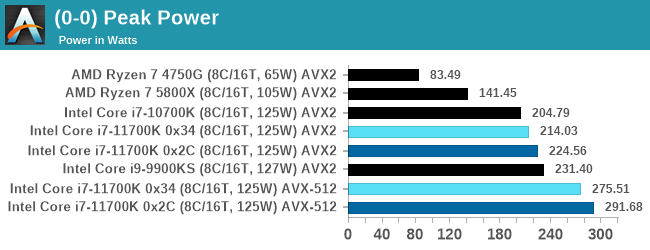



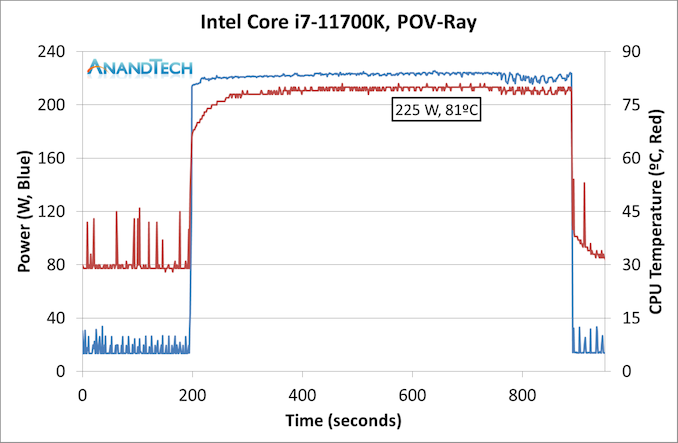
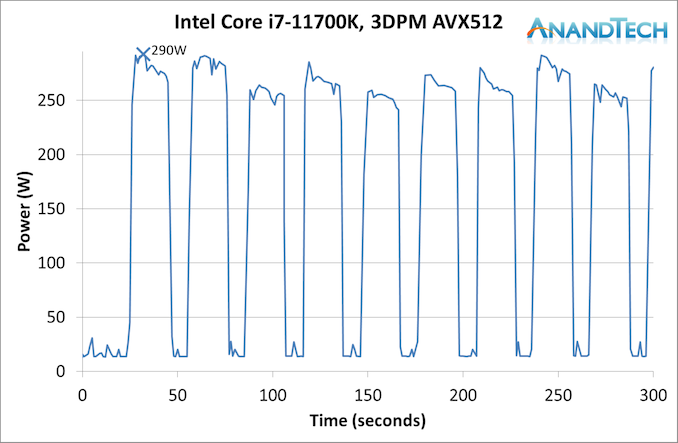
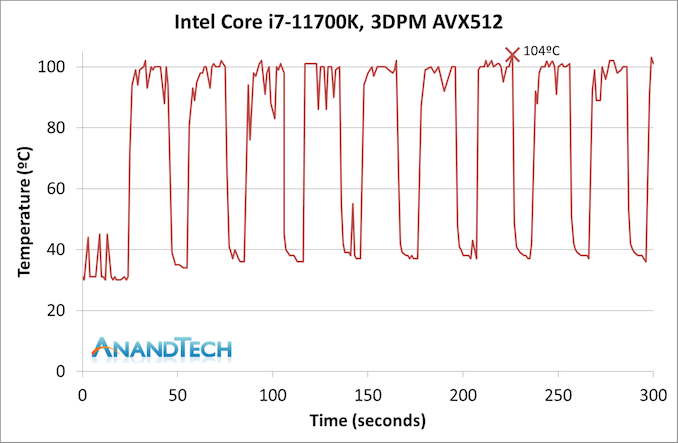


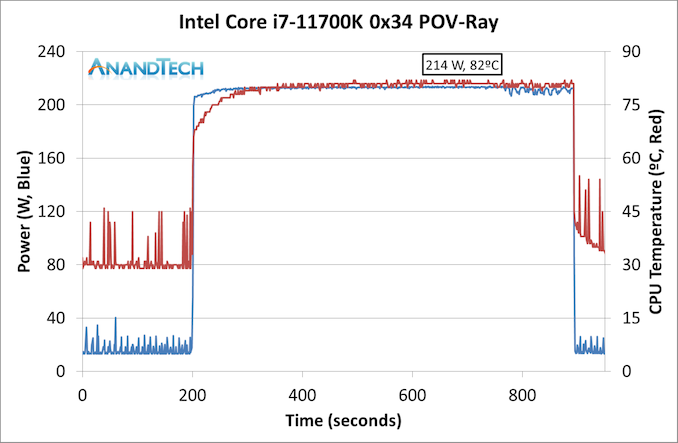








541 Comments
View All Comments
Hifihedgehog - Friday, March 12, 2021 - link
LOL. Fanboy delusion.First off, let's take a quick looksie at the Cinebench R20 results:
https://www.hardwareluxx.de/index.php/artikel/hard...
When switching from BIOS version 0402 to 0603, the 11700K's single-threaded performance actually DROPS from a score of 609 to 600. And its multicore performance is still less than the 10900K and the 5800X.
Switching gears, the games are no less unflattering:
https://www.hardwareluxx.de/index.php/artikel/hard...
The 11700K there, regardless of which of the two BIOS releases it uses, often loses to the 10900K and Ryzen 5000 series. It loses to the Ryzen 5000 series and 10900K in THREE out of the four games: The Division 2, Metro Exodus, The Shadow of the Tomb Raider.
In short: dude, what are you smoking?
Technobile - Friday, March 12, 2021 - link
The 10700K costs a pittance at the minute, and after the final bios and microcode 11700K will be around 15 to 20% faster than it. Both a bargain when the only other option is dealing with the 'quirks' (to be kind) of an AMD systemQasar - Friday, March 12, 2021 - link
" The 10700K costs a pittance at the minute, and after the final bios and microcode 11700K will be around 15 to 20% faster than it " i will believe that, when i see it, honestly, that is hopeful thinking." Both a bargain when the only other option is dealing with the 'quirks' (to be kind) of an AMD system " and intel has had its own quirks over the years.
dsplover - Saturday, March 13, 2021 - link
They’re just doing this to give the impression they’re relevant. It’s safe to assume they’ll retake some market share but AMD took servers, laptop and desktop sectors by storm while Intel keeps moving old designs out the door.AMD 5750G, if it exists will render Intel designs useless this summer, while Intel struggles to get Alder Lake up and running.
Motherboard manufacturers will get tired of chasing new sockets after AM5 comes out.
What happened to these guys? It’s embarrassing and I’m an i7 fan boy..
GeoffreyA - Saturday, March 13, 2021 - link
"What happened to these guys?"My guess would be: complacency, underestimating the enemy, putting eggs in too many dead-end baskets, and management that made a mess of excellent engineering talent.
CiccioB - Sunday, March 14, 2021 - link
When reading this I think some of you just ended their school yesterday (with poor results) and just came here to say the first thing they think it is pro AMD. Just to give a (poor) contribution to what they think is an easy (for everyone) task as beating a dead horse (Intel).
I may shock you if I say that that "chasing designs" effort is the secret trick for motherboard producer too... surprise surprise.. MAKE MONEY!
So they do not get tired to do anything if this means selling more motherboards, and this just happens if you have to change your motherboards every couple of generations.
And I may shock you even more if I say you that those that make an upgrade using the same motherboard is just a so small number that no motherboard producer is really interested in supporting.
Usually when you change your CPU you just do not want only it to go a little faster but you want also the new technological improvements that meantime have been created, from faster bus, new and more connectors (M2 vs SATA), faster USBs, Thunderbolts, better memory support and such.
And this doesn't come if you do not also change the motherboard.
And to have and propose a better motherboard to sell, guess what? Yes, motherboard producer have to play the "chasing designs" game.
rfxcasey - Thursday, March 18, 2021 - link
Yeah "useless", please, all of this is splitting hairs, none of these processors are even close to being "useless".rfxcasey - Wednesday, March 17, 2021 - link
To me, looks like the i7 10700k holds it's own against the 5800x in gaming performance and is much cheaper.rfxcasey - Thursday, March 18, 2021 - link
i7 10700K actually beating the 5800x in many game benchmarks. I don't have a preference between AMD and Intel generally, but the i7 10700K is a great gaming processor, Intel did seem to make an embarrassing move with the 11th Gen, but for the cost, the 10700k a top, possibly THE top gaming CPU.quadibloc - Thursday, March 18, 2021 - link
When an official review comes in, with all the details, things may look a little better. But even now, I see one thing that's being overlooked. Since these chips have AVX-512, where that can be used, that will double their performance compared to processors that only have AVX-256. Except, of course, for the necessary slowdown for thermal reasons. So on workloads that involve a lot of AVX-512, they should really shine instead of being as terribly lackluster as they appear when that isn't taken into account.